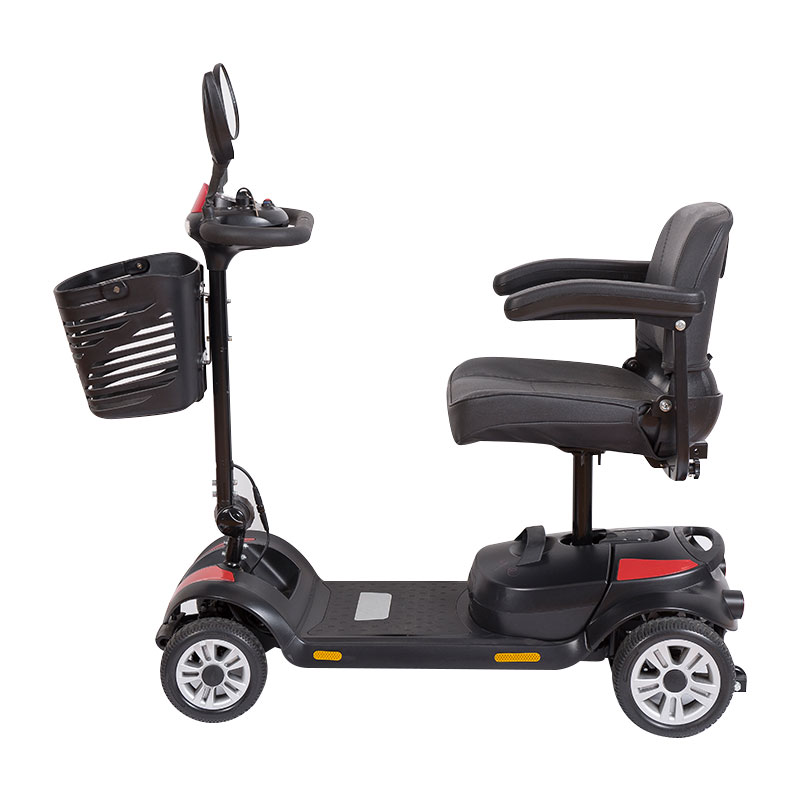What are the typical energy storage technologies used in four-wheeled elderly mobility scooters?
Elderly mobility scooters, particularly four-wheeled models, rely heavily on energy storage technologies to provide the necessary power for their operation. Here are the typical energy storage technologies used in these scooters:
Sealed Lead Acid (SLA) Batteries
Sealed Lead Acid batteries are one of the most common types of batteries used in elderly mobility scooters. They are popular due to their cost-effectiveness, reliability, and ease of maintenance. SLA batteries are known for:
Low Cost: They are cheaper than other battery technologies.
Robustness: They can handle a wide range of temperatures and are relatively durable.
Low Maintenance: These batteries are sealed, which means they don’t require regular maintenance like checking water levels.
Availability: Widely available and compatible with many scooter models.
However, they are relatively heavy and have a shorter lifespan compared to some other battery types.
Lithium-Ion Batteries
Lithium-ion batteries are becoming increasingly popular in mobility scooters due to their high energy density, which allows for longer travel distances and reduced weight. Key benefits include:
High Energy Density: They provide more energy per unit weight, leading to longer travel ranges.
Lightweight: Significantly lighter than SLA batteries, improving the scooter's overall efficiency.
Long Lifespan: They typically have a longer life cycle compared to lead-acid batteries.
Fast Charging: They charge quicker than lead-acid batteries, reducing downtime.
The main drawback is their higher initial cost compared to lead-acid batteries.
Nickel Metal Hydride (NiMH) Batteries
Nickel Metal Hydride batteries offer a middle ground between SLA and lithium-ion batteries in terms of performance and cost. Features include:
Higher Energy Density: Compared to SLA, they offer better energy density, though not as high as lithium-ion.
Moderate Weight: Lighter than SLA but heavier than lithium-ion.
Environmentally Friendly: They contain fewer toxic materials compared to SLA batteries.
Reasonable Cost: More affordable than lithium-ion but more expensive than SLA.
NiMH batteries are less commonly used than the other two types but still present in some models.

Lithium Iron Phosphate (LiFePO4) Batteries
A subtype of lithium-ion, Lithium Iron Phosphate batteries are known for their safety and long life. They offer:
Safety: They are less prone to overheating and thermal runaway compared to other lithium-ion batteries.
Longevity: Extremely long life cycles, often exceeding several thousand charge/discharge cycles.
Stable Chemistry: They have a stable discharge rate and are less susceptible to capacity degradation.
Their higher upfront cost is a drawback, but they can be cost-effective over the long term due to their durability.
Gel Batteries
A type of lead-acid battery, gel batteries use a gel electrolyte, which makes them spill-proof and maintenance-free. They provide:
Maintenance-Free Operation: No need to refill water or check electrolyte levels.
Spill-Proof: Safe to transport and install in any orientation.
Durability: Resistant to vibration and shock, making them suitable for rougher terrains.
They are more expensive than traditional lead-acid batteries and can be sensitive to charging conditions.
Comparison and Selection Criteria
When choosing a battery for a four-wheeled elderly mobility scooter, several factors need to be considered:
Range Requirements: Longer travel distances favor lithium-ion or LiFePO4 batteries due to their higher energy density.
Budget: SLA batteries are the most cost-effective in terms of initial investment, while lithium-ion batteries, though more expensive, offer lower long-term costs due to their longer lifespan.
Weight and Size: Lithium-ion and NiMH batteries are lighter and more compact, which can improve the scooter’s performance.
Maintenance Needs: SLA and gel batteries require less maintenance, which can be crucial for elderly users.
Safety: LiFePO4 batteries are the safest in terms of thermal stability and resistance to fire hazards.
Each type of battery has its unique advantages and trade-offs, and the choice often depends on the specific needs and preferences of the user, including factors like distance traveled, terrain, budget, and maintenance capability.


 English
English Deutsch
Deutsch







-3.jpg?imageView2/2/format/jp2)
.jpg?imageView2/2/format/jp2)






